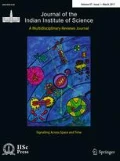Abstract
Sensory systems adapt to environmental change. It has been argued that adaptation should have the effect of optimizing sensitivity to the new environment. Here we consider a framework in which this premise is made concrete using an economic normative theory of visual motion perception. In this framework, visual systems adapt to the environment by reallocating their limited neural resources. The allocation is optimal when uncertainties about different aspects of stimulation are balanced. This theory makes predictions about visual sensitivity as a function of environmental statistics. Adaptive optimization of the visual system should be manifested as a change in sensitivity for an observer and for the underlying motion-sensitive neurons. We review evidence supporting these predictions and examine effects of adaptation on the neuronal representation of visual motion.











Similar content being viewed by others
Notes
These uncertainties concern location and frequency content of stimuli, defined according to the information theory of Gabor6.
Change maps for all subjects appear in Fig S2 in Gepshtein et al.9.
This dimension could be space or time. For example, when x represents space, the larger number of lower level cells, from which the cell I receive information, corresponds to a larger receptive field size of I.
References
Albright TD (1984) Direction and orientation selectivity of neurons in visual area MT of the macaque. J Neurophysiol 52:1106–1130
Barlow HB (1990) A theory about the functional role and synaptic mechanism of visual after-effects. In: Blakemore C (ed) Vision: coding and efficiency. Cambridge University Press, Cambridge, pp 363–375
Bi G, Poo M (2001) Synaptic modification by correlated activity: Hebb’s postulate revisited. Annu Rev Neurosci 24:139–166. https://doi.org/10.1146/annurev.neuro.24.1.139
Bienenstock EL, Cooper LN, Munro PW (1982) Theory for the development of neuron selectivity: orientation specificity and binocular interaction in visual cortex. J Neurosci 2:32–48
Dong D, Atick J (1995) Statistics of natural time-varying images. Netw Comput Neural Syst 6:345–358. https://doi.org/10.1088/0954-898X/6/3/003
Gabor D (1946) Theory of communication. Institution of electrical engineers. 93 (Part III):429–457
Gepshtein S (2014) Economy of vision and adaptive reallocation of neural resources. J Vis 14:15. https://doi.org/10.1167/14.15.11
Gepshtein S, Jurica P, Tyukin I, van Leeuwen C, Albright TD (2012) Receptive field plasticity and visual adaptation. 467.16. 2012 Neuroscience Meeting Planner. Society for Neuroscience, New Orleans
Gepshtein S, Lesmes LA, Albright TD (2013) Sensory adaptation as optimal resource allocation. Proc Natl Acad Sci USA 110(11):4368–4373
Gepshtein S, Tyukin I, Kubovy M (2007) The economics of motion perception and invariants of visual sensitivity. J Vis 7(8):1–18
Jurica P, Gepshtein S, Tyukin I, van Leeuwen C (2013) Sensory optimization by stochastic tuning. Psychol Rev 120(4):798–816
Kelly DH (1979) Motion and vision. II. Stabilized spatio-temporal threshold surface. J Opt Soc Am. 69:1340–1349
Knill DC, Richards W (1996) Perception as Bayesian inference. Cambridge University Press, Cambridge
Krekelberg B, van Wezel RJ, Albright TD (2006) Adaptation in macaque MT reduces perceived speed and improves speed discrimination. J Neurophysiol 95:255–270
Kujala J, Lukka T (2006) Bayesian adaptive estimation: the next dimension. J Math Psychol 50(4):369–389
Lesmes LA, Gepshtein S, Lu Z-L, Albright T (2009) Rapid estimation of the spatiotemporal contrast sensitivity surface. J Vis 9(8):696. https://doi.org/10.1167/9.8.696
Lesmes LA, Jeon S-T, Lu Z-L, Dosher BA (2006) Baysian adaptive estimation of threshold versus contrast external noise functions: the quick TvC method. Vis Res 46:3160–3176
Lesmes LA, Lu Z-L, Baek J, Albright TD (2010) Bayesian adaptive estimation of the contrast sensitivity function: the quick CSF method. J Vis 10(3):1–21
Maloney LT (2002) Statistical decision theory and biological vision. In: Heyer D, Mausfeld R (eds) Perception and the physical world. Wiley, New York, pp 145–189
Mather G, Verstraten F, Anstis SM (1998) The motion aftereffect: a modern perspective. The MIT Press, Cambridge, p 220
Nakayama K (1985) Biological image motion processing: a review. Vis Res 25:625–660
Paulsen O, Sejnowski TJ (2000) Natural patterns of activity and long-term synaptic plasticity. Curr Opin Neurobiol 10:172–179. https://doi.org/10.1016/S0959-4388(00)00076-3
Pawar A, Laddis P, Gepshtein S, Albright T (2013) Measuring the spatiotemporal contrast sensitivity function in the macaque monkey. J Vis 13(9):366. https://doi.org/10.1167/13.9.366 http://jov.arvojournals.org/article.aspx?articleid=2142473
Robson JG (1966) Spatial and temporal contrast sensitivity functions of the visual system. J Opt Soc Am. 56:1141–1142
Robson JG (1993) Contrast sensitivity: One hundred years of clinical measurement. In: Shapley RM, Lam DMK (eds). Contrast sensitivity. MIT Press, Cambridge pp 253–267
Sakitt B, Barlow HB (1982) A model for the economical encoding of the visual image in cerebral cortex. Biol Cybern 43:97–108
Simoncelli EP, Olshausen BA (2001) Natural image statistics and neural representation. Annu Rev Neurosci 24:1193–1215
Stocker A, Simoncelli E (2005) Sensory adaptation within a bayesian framework for perception. In: Weiss Y, Scholkopf B, Platt J (eds) NIPS advances in neural information processing systems, 18. MIT Press, Cambridge, pp 1291–1298
Thiele A, Dobkins KR, Albright TD (2000) Neural correlates of contrast detection at threshold. Neuron 26:715–724
Watson AB, Ahumada AJ (2016) The pyramid of visibility. Human Vis Electron Imag 2016:1–6. https://doi.org/10.2352/ISSN.2470-1173.2016.16HVEI-102
Weiss Y, Simoncelli EP, Adelson EH (2002) Motion illusions as optimal percepts. Nat Neurosci 5:598–604
Author information
Authors and Affiliations
Corresponding author
Electronic supplementary material
Below is the link to the electronic supplementary material.
Rights and permissions
About this article
Cite this article
Gepshtein, S., Albright, T.D. Adaptive Optimization of Visual Sensitivity. J Indian Inst Sci 97, 423–434 (2017). https://doi.org/10.1007/s41745-017-0056-y
Received:
Accepted:
Published:
Issue Date:
DOI: https://doi.org/10.1007/s41745-017-0056-y




